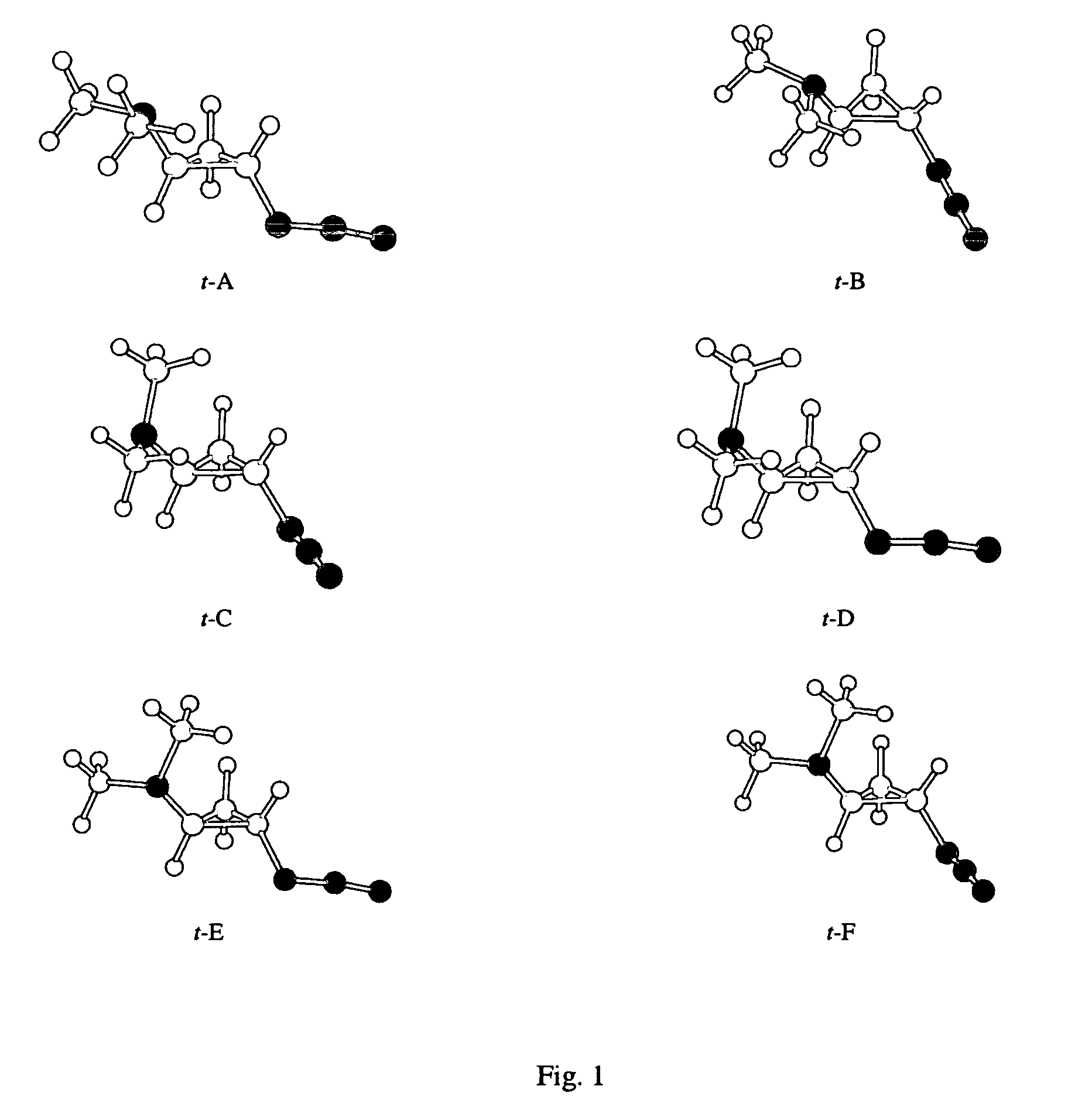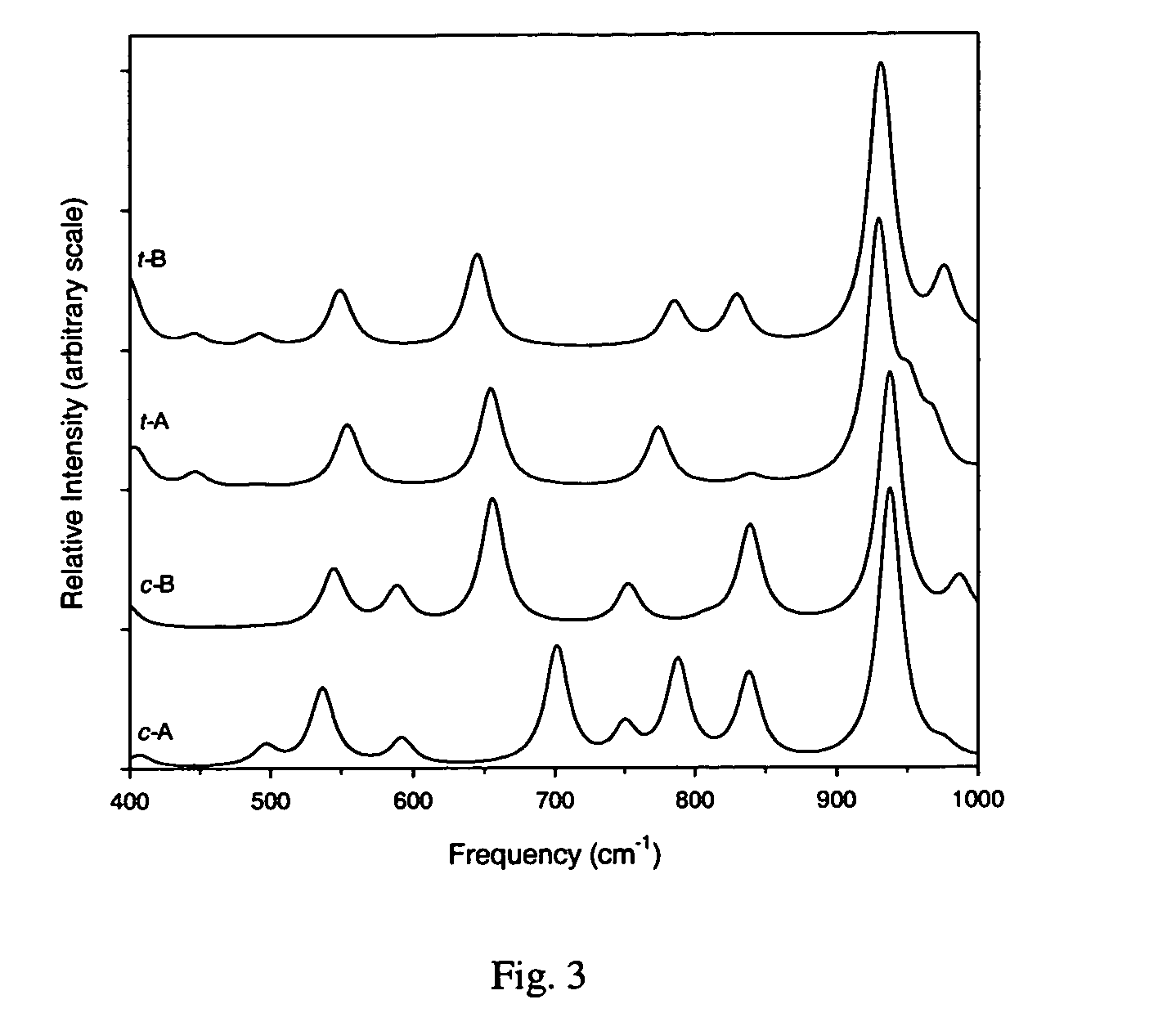Amine azide propellant
a technology of amine azide and propellant, which is applied in the direction of fuels, weaving, explosives, etc., can solve the problems of increasing the accumulation of unreacted propellant in the combustion chamber prior to ignition, requiring cost-effective handling procedures, and not meeting the higher performance standards of monomethylhydrazine-irfna systems
- Summary
- Abstract
- Description
- Claims
- Application Information
AI Technical Summary
Problems solved by technology
Method used
Image
Examples
example 1
Computational Quantum Chemistry Results for 2-azido-N,N-dimethylcyclopropanamine (ADMCPA)
[0020]The Gaussian 98 (G98) suite of quantum chemistry codes (M. J. Frisch et al., Gaussian 98, Revision A.4., Gaussian, Inc., Pittsburgh, Pa. 1998.) is employed to identify equilibrium 2-azido-N,N-dimethylcyclopropanamine (ADMCPA) structures and characterize their normal modes. Density functional theory utilizing the B3LYP exchange-correlation functionals (A. D. Becke “Density-functional Thermochemistry.3. The Role of Exact Exchange.”Journal of Chemical Physics, vol. 98, pp. 5684–5652, 1993; C. Lee et al. “Development of the Colle-Salvetti Correlation-Energy Formula Into a Functional of the Electron-Density.”Physical Review B, vol. 37, pp. 785–789, 1988; B. Miehlich et al. “Results Obtained With The Correlation-Energy Density Functionals Of Becke And Lee, Yang And Parr.”Chemical Physics Letters, vol. 157, pp. 200–206, 1989) and 6-311++G(d,p) atomic orbital basis set (T. Clark et al., “Efficient...
example 2
Computational Quantum Chemistry Results for 2-azido-N-methylcyclobutanamine (AMCBA)
[0025]The methods of Example 1 are repeated with the substitution of 2-azido-N-methylcyclobutanamine (AMCBA) for ADMCPA. Equilibrium AMCBA structures are shown in FIG. 4. Conformers shown in FIG. 4 were obtained via geometry optimizations from starting structures expected to be energetically favored based on the ADMCPA optimal structures. The cis isomers of AMCBA include a configuration with interacting amine and azide groups that is 1.0 kcal / mol lower in energy than otherwise similar conformers. Thus, a population dominated by a shielded configuration for the amine group is expected for the cis forms. Trans AMCBA allows closer proximity between the azido and amine groups (0.371 nanometers from the amine nitrogen to the middle nitrogen of the azide group) than in trans ADMCPA (0.429 nanometers for t-B).
example 3
Computational Quantum Chemistry of 2-azidocyclopentanamine (ACPA)
[0026]The methods of Example 1 are repeated substituting the structure of 2-azidocyclopentanamine (ACPA) for ADMCPA. An equilibrium ACPA structure is shown in FIG. 5. Trans ACPA allows closer proximity between the azido and amine groups (0.316 nanometers) as compared to trans ADMCPA (0.429 nanometers for t-B).
PUM
| Property | Measurement | Unit |
|---|---|---|
| energy yield | aaaaa | aaaaa |
| energy density | aaaaa | aaaaa |
| weight | aaaaa | aaaaa |
Abstract
Description
Claims
Application Information
 Login to View More
Login to View More - R&D
- Intellectual Property
- Life Sciences
- Materials
- Tech Scout
- Unparalleled Data Quality
- Higher Quality Content
- 60% Fewer Hallucinations
Browse by: Latest US Patents, China's latest patents, Technical Efficacy Thesaurus, Application Domain, Technology Topic, Popular Technical Reports.
© 2025 PatSnap. All rights reserved.Legal|Privacy policy|Modern Slavery Act Transparency Statement|Sitemap|About US| Contact US: help@patsnap.com



